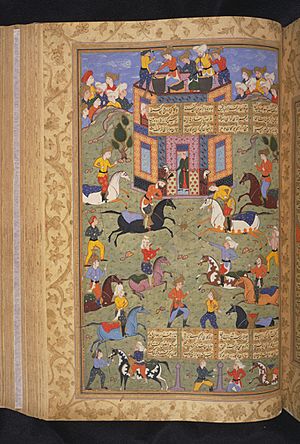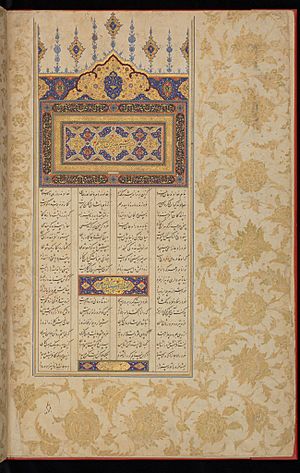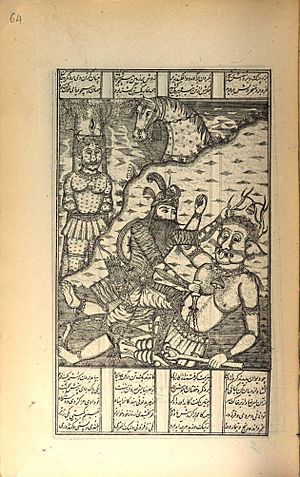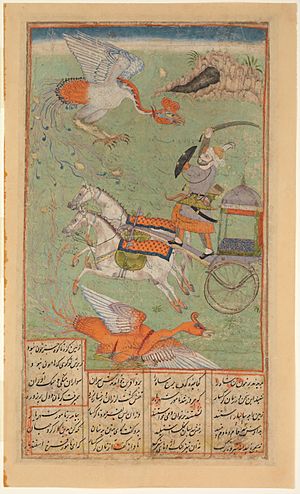Shahnameh facts for kids
| The Book of Kings | |
| by Ferdowsi | |

Court of Keyumars, Miniature by Sultan Muhammad from the Shahnameh of Shah Tahmasp . Aga Khan Museum
|
|
| Original title | شاهنامه |
|---|---|
| Written | 977–1010 CE |
| Country | Iran |
| Language | Classical Persian |
| Subject(s) | Persian mythology, history of Iran |
| Genre(s) | epic poem |
| Meter | Lines of 22 syllables with two rhyming couplets in the same metre (bahr-i mutaqarib-i mahzuf) |
| Publication date | 1010 |
| Published in English | 1832 |
| Media type | manuscript |
| Lines | c. 50,000 depending on manuscript |
| Preceded by | Khwaday-Namag |
| Read online | "Shahnameh" at Wikisource |

The Shahnameh (Persian: شاهنامه, romanized: Šāhnāme), also called Shahnama, is a very long epic poem. It was written by the Persian poet Ferdowsi between about 977 and 1010 CE. This poem is the national epic of Greater Iran.
The Shahnameh has about 50,000 "couplets" (two-line verses). This makes it one of the longest epic poems in the world. It tells stories about the mythical and historical past of the Persian Empire. The stories go from the creation of the world up to the Muslim conquest in the 7th century. Countries like Iran, Azerbaijan, Afghanistan, and Tajikistan celebrate this important national epic. Other regions influenced by Persian culture also celebrate it.
This work is super important in Persian culture and for the Persian language. People see it as a masterpiece of literature. It helps define the cultural identity of Iran.
Amazing Illustrated Copies

Many copies of the Shahnameh have beautiful pictures. These pictures are some of the best examples of Persian miniature painting. Several old copies are still complete today. Two very famous ones, the Houghton Shahnameh and the Great Mongol Shahnameh, were split up. Their pages were sold separately in the 1900s. One page from the Houghton Shahnameh sold for a lot of money in 2006.
The Baysonghori Shahnameh is another special copy. It is an illuminated manuscript, meaning it has amazing decorations. This copy is part of UNESCO's Memory of the World Register. This means it's recognized as an important cultural treasure.
Rulers in Iran, like the Mongol rulers, really liked the Shahnameh. They helped make more illustrated copies. The "Great Mongol" or Demotte Shahnameh was made when Sultan Abu Sa'id was in charge. It is one of the most important and detailed copies. The Timurids also continued making these special books.
During the 15th century, many illustrated Shahnameh manuscripts were made. This happened under the Qarā-Qoyunlu and Āq Qoyunlu Turkman dynasties. Many copies with more than seventy paintings come from cities like Tabriz, Shiraz, and Baghdad.
The Safavid era saw a big increase in Shahnameh productions. Shah Ismail I used the epic to show Persian pride. It celebrated new Persian rule and showed the power of the Persian kings. The Safavids ordered very fancy copies of the Shahnameh to prove their right to rule. One amazing example is a series of 250 small paintings. Shah Ismail ordered these for his son's Shahnameh of Shah Tahmasp. Two similar sets of illustrations from the mid-17th century are the Shahnameh of Rashida and the Windsor Shahnameh. These are from the last great time of Persian miniature art.
In 2010, the Fitzwilliam Museum in Cambridge had a big exhibition. It was called "Epic of the Persian Kings: The Art of Ferdowsi’s Shahnameh". This celebrated 1000 years of the Shahnameh. The Arthur M. Sackler Gallery in Washington, DC, also had an exhibition. It showed pages from the 14th to 16th centuries.
In 2013, Hamid Rahmanian created new pictures for a new English translation of the Shahnameh. He used old manuscripts as inspiration.
Modern Translations


The Shahnameh has been translated into English many times. Most of these translations are shorter versions. James Atkinson made an English translation in 1832. Later, between 1905 and 1925, brothers Arthur and Edmond Warner published a full translation in nine books.
More recently, Reuben Levy made a prose (story-like) version in 1967. Dick Davis also made a translation in 2006 that mixed poetry and prose. A new English prose translation by Ahmad Sadri came out in 2013.
The Parsis, who are Zoroastrians, moved to India a long time ago to practice their religion freely. They have also helped keep the Shahnameh stories alive. Dr. Bahman Sohrabji Surti published the first detailed and complete English translation from the original Persian. This was done between 1986 and 1988 in seven books. The Shahnameh has also been translated into other languages like French, German, Italian, Gujarati, and Spanish.
See also
 In Spanish: Shāhnāmé para niños
In Spanish: Shāhnāmé para niños
- List of Shahnameh characters
- List of places in Shahnameh
- List of women in Shahnameh
- Rostam and Esfandiyar
- Rostam's Seven Labours
- Zal and Rudaba
- Naqqāli, a performing art based on Shahnameh
- Rostam and Sohrab, an opera
- Sohrab and Rustum, an 1853 poem
- Vis and Rāmin, another epic poem
- Mir Jalaleddin Kazzazi
- Shahrokh Meskoob
Images for kids
-
Georgian manuscript of Shahnameh written in the Georgian script.
-
An image showing the parable of the ship of faith from the Houghton Shahnameh (Metropolitan Museum of Art)














